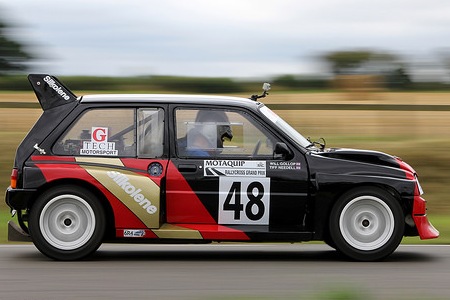Background
The 4 wheel drive mid engined MG Metro 6R4 (6-cylinder, rally car, four-wheel-drive) was developed and built on Rover’s behalf by Williams Grand Prix Engineering.
The car was powered by a longitudinally mounted 3 ltr DOHC 24 valve normally aspirated V6 engine, which is rotated 180 degrees so the gearbox is in board of the rear mounted engine. The four-wheel-drive was permanently engaged, and drove separate propshafts to the front and rear differentials. The rear differential was mounted on the side of the engine sump with one driveshaft running through the sump to the nearside rear wheel. There is very little remaining of the original bodywork, with the doors and roof being the only remaining metal parts of the body shell. The wings bonnet and tail gate are constructed of GRP
The 6R4 originally appeared in two variants, the first of which was the Clubman spec which was the road going version developing in the region of 250 bhp, which cost £40,000, the second was the International spec which developed around 410 bhp
The 6R4 never reached its full potential on the rally scene, as its only real season of competition was marred by teething trouble with the engine, and as Group B cars were outlawed by the FISA in 1986, its development was cut short. Despite its World Rally Championship appearances being cut short, the car did go on to substantial success in both the British and European Rallycross Championships.
This Car
This was registered as D479 PDM and was originally prepared by RED for rallying. It went through a number of hands and before eventually arriving at the door of the famous Rallycross driver Will Gollop in 1988. Will prepared it in his famous Silkolene colours for Tiff Needell’s use in the 1988 British Rallycross Grand Prix. The Silkolene colours must have been magic as Tiff finished 4th in the B-Final on what was his first Rallycross event.
Tiff returned the following year, but was denied the chance to improve on his result, as heavy fog caused the event to be cancelled after the practice sessions.
The history post the event is at present patchy, but it made its way through a few hands before ending up near the arctic circle at the top of Finland in the hands of an enthusiastic rally driver who used it on a number of events. The car was then purchased by its current owner in early 2015, who has undertaken a thorough restoration and returned it to its former glory.
Technical
Engine: 3 ltr
Cylinders: V6
Aspiration: Naturally Aspirated
Valves: 24
Camshafts: Twin DOHC
Carburetion: Fuel Injected
Transmission: 5 speed
Drive: 4WD
BHP: 410

